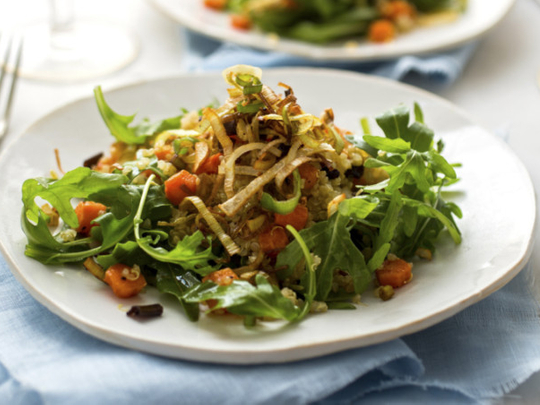
Quinoa — an ancient Andean grain — is proving a successful crop in the UAE, according to the results of trials in six locations around the country released on Monday. The UAE ministry of environment and water says with yields of five tonnes per hectare, the UAE’s quinoa tests are outperforming some international locations. While the ministry is hopeful the crop — which although cooked like a grain, is not one (it’s actually more closely related to beets and spinach) — can be used for both human and livestock feed, and protect the UAE against food insecurity; health-food lovers have been downing bowlfuls of the high-protein, vegan and gluten-free food for years. Here are four things to know about quinoa (pronounced keen-wah):
What does quinoa taste like?
Quinoa is an ancient food from South America. While it looks a bit like rice, it has a richer, heartier flavour and crunchier texture. Dietriffic.com describes the taste as “brown rice crossed with oatmeal” that is “fluffy, creamy, crunchy and somewhat nutty, all rolled into one”. Stonesoup calls it “something a little like barley with its chewiness”, combined with “a light fluffiness akin to well-prepared couscous”.
Not everyone is a fan. A Vancouver Observer columnist recently listed “five reasons to hate quinoa”, including that some types of uncooked quinoa have the translucent appearance of silica gel, and that it tastes like “beige”.
Why is quinoa suddenly so popular?
While quinoa seems to have become fashionable overnight, its rise has been years in the making. In 1913, The New York Times reported that quinoa was among 400 “charming botanical strangers” to be introduced in America by the Department of Agriculture. Food writers have been talking about its nutritional quality and taste since the 1980s, but it remained primarily a niche health-store product.
Quinoa’s popularity stems from its reputation as a “complete” food. It has a protein content of about 15 per cent, and a balance of important amino acids, magnesium, calcium, and other minerals and vitamins. In 2008, Oprah Winfrey embarked on a 21-day “cleanse” diet that included quinoa with mushrooms, herbs and garlic as comfort food. American supermarkets also began to carry and promote quinoa.
Datamyne reports that the US imported about 25,000 metric tonnes of quinoa in 2012, up from about 5,000 in 2008.
In 2010, a cookbook, Quinoa 365: The Everyday Superfood by Patricia Green and Carolyn Hemming, became a bestseller. The UN labelled 2013 the International Year of Quinoa, and recipes using quinoa are now a staple of food blogs and cooking columns.
“Even though it seems like overnight, there hasn’t been one single event that has catalysed the popularity of quinoa,” said Kevin Murphy, an assistant professor of barley and alternative crop breeding at Washington State University. “When we started doing quinoa research, people would laugh. Nobody knew what it was.”
How do you cook quinoa?
Quinoa can be cooked like rice or boiled vigorously such as pasta. Home cooks and food writers experiment with different methods, depending on whether they want a crunchier or creamier texture.
Martha Rose Shulman, who writes the Recipes for Health column in The New York Times, said she recently reduced the amount of water she uses to cook quinoa. “The grains were tighter and less moist than quinoa cooked in abundant water, and the yield was not as great because the grains don’t swell as much,” she wrote. “But I liked the results.”
What is the future of quinoa?
Most quinoa eaten in America comes from South America, where farmers are eager to cultivate the plant because of rising prices. (Some llama herders are reported to have switched to quinoa farming because it is more lucrative).
The Department of Agriculture has awarded a grant to researchers at Washington State who are studying ways to help farmers grow quinoa. At present, 35 varieties are cultivated in the US, and scientists are trying to determine the best growing conditions.
In one study, researchers are trying to determine if quinoa plants are more resistant to certain insects than wheat and barley are. “Not a day goes by that I don’t get five or six e-mails and calls from farmers asking what seeds to plant or how to grow it,” Murphy said.
— New York Times News Service








